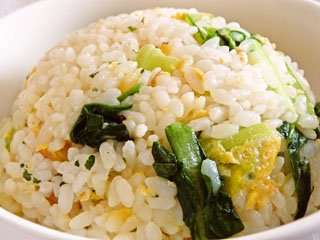Selection and storage
Komatsuna can be harvested at any stage- from microgreens to flowering tops. While young, its leaves have a mild flavor and are prepared much like spinach. As the plant grows, the stems become tougher, and flavor grows stronger and hotter, and hence, require a longer cooking time.
In the market, look for fresh greens featuring crispy, dark green leaves. Avoid wilt, spotted, or discolored leaves.
At home, keep the leaves in the refrigerator soon after buying as they wither soon if kept at room temperature.
Although they can be stored for up to 3 days in cold storage, fresh komatsuna greens should be used as soon as possible to get benefits.
Preparation and serving methods
Komatsuna is a popular green-leafy vegetable in the Japanese diet. Fresh leaves, flower buds, and stems are used in a variety of cuisines all over East-Asia.
Before cooking, wash the leaves thoroughly in clean running water to remove sand/dirt and then rinse in saline water for about 30 minutes to remove any insecticide residues. Trim away thick petioles and stems.
Here are some serving tips:
 |
| Fried rice with eggs and Komatsuna. Courtesy: Kakei.R |
-
Fresh tender Japanese mustard-spinach greens are eaten raw either as a salad or enjoyed juiced.
-
Prepare simple fried rice with eggs and Japanese mustard spinach (小松菜の炒飯).
-
In Japan, mature komatsuna leaves are steam-cooked alone or mixed with other greens such as spinach in ohitashi. Boiled greens seasoned with dried bonito flakes, sesame seeds, and soy sauce broth as a dressing to flavor and to tame the pungent, peppery flavor.
-
Use in dashi-soups mixing with chicken, mushroom, and chopped green onions.
-
Komatsuna can be substituted for napa (Chinese) cabbage for a more highly flavored version of kimchee.
Safety profile
-
Reheating of Japanese spinach leftovers may cause conversion of nitrates to nitrites and nitrosamines by certain bacteria that thrive on prepared nitrate-rich foods, such as komatsuna, spinach, and many other green vegetables. These poisonous compounds may prove harmful to health.
-
Phytates and dietary fiber present in the komatsuna may interfere with the bioavailability of iron, calcium, and magnesium.
-
Komatsuna, being a Brassica family vegetable, contains oxalic acid, a naturally occurring substance found in some vegetables which may crystallize as oxalate stones in the urinary tract in some people. People with known oxalate urinary tract stones are advised to avoid eating vegetables belong to the Brassica family. Adequate intake of water is, therefore, necessary to maintain normal urine output.
-
Komatsuna may also contain goitrogens which may interfere with thyroid hormone production and can cause thyroxin hormone deficiency in individuals with thyroid dysfunction.
(Medical Disclaimer: The information and reference guides on this website are intended solely for the general information of the reader. It is not to be used to diagnose health problems or for treatment purposes. It is not a substitute for medical care provided by a licensed and qualified health professional. Please consult your health care provider for any advice on medications.)
You may also like to read ≻≻
-
≺≺ Mizuna Nutrition facts.
-
≺≺ Broccoli rabe Health benefits.
-
≺≺ Chinese broccoli (Gai lan) Health benefits.
-
≺≺ Tatsoi (spoon mustard) Health benefits.
-
≺≺ Mustard-greens Health benefits.
≺≺ Back to Vegetables from Komatsuna. Visit here for an impressive list of vegetables with complete illustrations of their nutrition facts and health benefits.
≺≺ Back to Home page.
Further reading:
-
Refer Stanford School of Medicine Cancer information Page- Nutrition to Reduce Cancer Risk (Link opens in new window).
-
Kitazawa Seed Company (Link opens in new window).
-
Specialty Produce (Link opens in new window).

